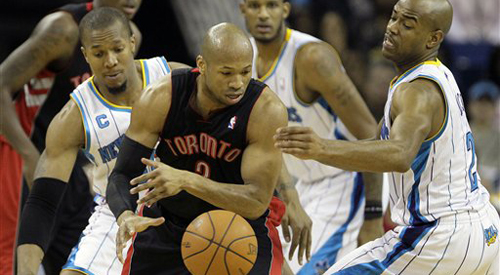
The NBA Explained: 10-Day Contracts
A few weeks ago, the Toronto Raptors added guard Sundiata Gaines to their roster. The move prompted a shared response from Raptors fans throughout the country: “Who the heck is Sundiata Gaines?”
Unfortunately, supporters of the team couldn’t get acquainted with their newest Raptor because he was well gone before such an opportunity was ever granted.
Gaines is a member of a unique fraternity of NBA players; all of whom are bound by a special agreement: the 10-day contract.
The 10-day contract is designed for the so-called journeymen; players more along the lines of freelancers than long-term contributors. As explained by Larry Coon on his NBA salary capwebsite, CBAFAQ.com, the arrangement is a “contract which lasts 10 days (or three games, whichever comes later). A team may sign a player to two 10-day contracts in one season (they may or may not be consecutive). After the second 10-day contract, the team can only retain the player by signing him for the remainder of the season.”
It’s a simple objective: Impress the coaching staff within 10 days or return to obscurity.
There’s no time to settle down. No time to make a nest. No time to find off-court similarities with your teammates. It’s 10 days of extreme commitment, hard work and perhaps a little luck.
There are also some stipulations.
[php snippet=1]
“A team can’t have more 10-day contracts than they have players on their Inactive List,” Coon writes. “10-day contracts are available to be used starting Jan. 5 (or the first business day thereafter) each season.”
The most unique aspect of the 10-day contract is that it only exists in professional basketball. Never has such a treaty been used in football, hockey, baseball or soccer (at least in North America). So why does it only subsist in basketball?
Craig Kwasniewski, co-creator of The Association Blog, feels the 10-day contract is the result of limited roster size and a lack of direct affiliation between the NBA and minor basketball leagues.
“[NBA] rosters cannot exceed 15 players, compared to 55 for the NFL, 24-40 for MLB and 23 for the NHL,” says Kwasniewski. “Plus, the NHL and MLB have one or more minor league teams affiliated with each franchise.”
Injuries also play a role.
“Injuries are part of the game and the limited roster size forces teams to ‘try out’ for spots in case a player is placed on an injury list,” Kwasniewski explains. “In today’s economy, many teams go with rosters of 13 or 14 players instead of committing to 15 guaranteed contracts. So you’ll see a lot of 10-day contract action as injuries mount up.”
Keeping a seat on the sidelines warm seems to be the major responsibility for players on 10-day contracts. The chances of becoming a key contributor – let alone starter – are just as good as winning the lottery, getting struck by lightning and finding Jimmy Hoffa’s remains all on the same day.
But there are rare exceptions.
Kwasniewski points to Anthony Mason and Kurt Rambis, two players who turned 10-day contracts into full-length careers.
For players like Sundiata Gaines, the chances are slim. But they’re willing to take a 10-day contract because they might be that one player out of 100 who blossoms. If they fail, they’ll look for another chance and hope karma is on their side. Their desire outweighs reality.
So next time you see a player on a 10-day contract enter a game, don’t brush them off. You might – and I emphasize might – be watching a potential All-Star.
[php snippet=1]

